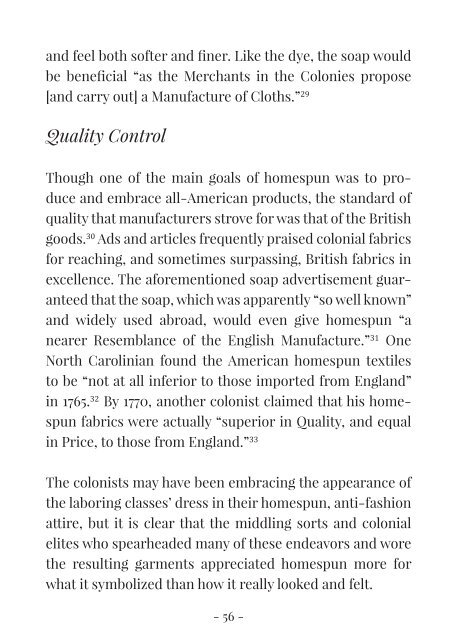The Fleece of Their Flock: Homespun & the American Identity
This interdisciplinary thesis project was researched, written, and designed by Jessica Vodnik and submitted in fulfillment of the Honors Senior Capstone requirement for the DePaul University Honors Program. Please do not copy, reproduce, or distribute without permission. Dr. Amy Tyson, Director, American Studies Dr. John Burton, Second Reader, History Undergraduate Honors Senior Thesis DePaul University, Chicago, IL May 10, 2015
This interdisciplinary thesis project was researched, written, and designed by Jessica Vodnik and submitted in fulfillment of the Honors Senior Capstone requirement for the DePaul University Honors Program. Please do not copy, reproduce, or distribute without permission.
Dr. Amy Tyson, Director, American Studies
Dr. John Burton, Second Reader, History
Undergraduate Honors Senior Thesis
DePaul University, Chicago, IL
May 10, 2015
You also want an ePaper? Increase the reach of your titles
YUMPU automatically turns print PDFs into web optimized ePapers that Google loves.
and feel both s<strong>of</strong>ter and finer. Like <strong>the</strong> dye, <strong>the</strong> soap would<br />
be beneficial “as <strong>the</strong> Merchants in <strong>the</strong> Colonies propose<br />
[and carry out] a Manufacture <strong>of</strong> Cloths.” 29<br />
Quality Control<br />
Though one <strong>of</strong> <strong>the</strong> main goals <strong>of</strong> homespun was to produce<br />
and embrace all-<strong>American</strong> products, <strong>the</strong> standard <strong>of</strong><br />
quality that manufacturers strove for was that <strong>of</strong> <strong>the</strong> British<br />
goods. 30 Ads and articles frequently praised colonial fabrics<br />
for reaching, and sometimes surpassing, British fabrics in<br />
excellence. <strong>The</strong> aforementioned soap advertisement guaranteed<br />
that <strong>the</strong> soap, which was apparently “so well known”<br />
and widely used abroad, would even give homespun “a<br />
nearer Resemblance <strong>of</strong> <strong>the</strong> English Manufacture.” 31 One<br />
North Carolinian found <strong>the</strong> <strong>American</strong> homespun textiles<br />
to be “not at all inferior to those imported from England”<br />
in 1765. 32 By 1770, ano<strong>the</strong>r colonist claimed that his homespun<br />
fabrics were actually “superior in Quality, and equal<br />
in Price, to those from England.” 33<br />
<strong>The</strong> colonists may have been embracing <strong>the</strong> appearance <strong>of</strong><br />
<strong>the</strong> laboring classes’ dress in <strong>the</strong>ir homespun, anti-fashion<br />
attire, but it is clear that <strong>the</strong> middling sorts and colonial<br />
elites who spearheaded many <strong>of</strong> <strong>the</strong>se endeavors and wore<br />
<strong>the</strong> resulting garments appreciated homespun more for<br />
what it symbolized than how it really looked and felt.<br />
- 56 -


